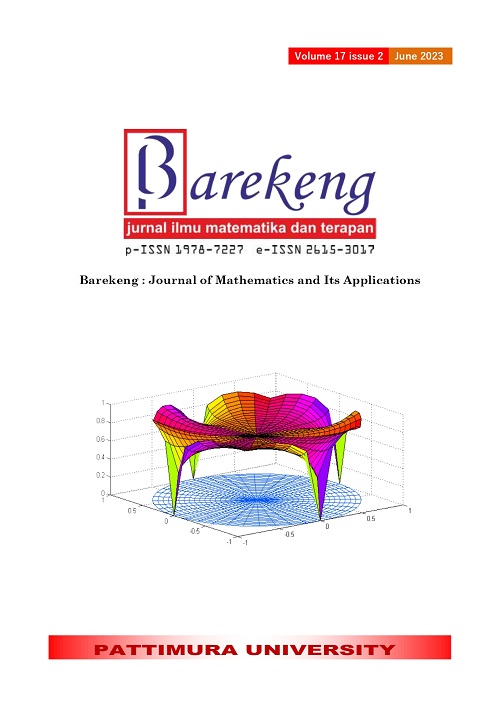MODELING HIV/AIDS USING SHAT MODEL
Abstract
HIV/AIDS gets on the list of deadly infectious diseases, but there is no right medicine and vaccination for it until now. Indonesia is also inseparable from the spread of HIV/AIDS year by year number of people living with HIV/AIDS in Indonesia continues to grow. The peak of HIV cases over the last twelve years (starting from 2020) in Indonesia was 50,282 cases in 2019, then the peak of AIDS was 12,214 in 2013. The purpose of the study is to model the spread of HIV/AIDS and test it with data on the growth of HIV/AIDS in Indonesia from 2006 to 2018. The steps taken in conducting this research are to determine the equilibrium point, calculate the basic reproduction number, analyze the stability of the equilibrium point, and numeric simulation of the SHAT model with the Maple 18 tool. Numerical simulation produces a value of . Based on calculations using the Routh-Hurwitz table, we can find that the system will be asymptotically stable towards a disease-free equilibrium point, namely . Based on the results obtained, it can conclude that HIV/AIDS will not become an epidemic in Indonesia.
Downloads
References
Khairani, InfoDATIN HIV/AIDS. Jakarta Selatan: Pusat Data dan Informasi Kementerian Kesehatan RI.
W. H. Organization, “Fact Sheets : HIV/AIDS,” 2021. https://www.who.int/news-room/fact-sheets/detail/hiv-aids
R. K. Nagle, E. B. Saff, dan A. D. Snider, Fundamentals of differential equations, Ninth. Boston: Pearson Education, Inc., 2018. doi: 10.1142/6643.
S. C. Chladná, Z., Kopfová, J., Rachinskii, D., & Rouf, “Global dynamics of SIR model with switched transmission rate,” J. Math. Biol., vol. 80, no. 4, hal. 1209–1233, 2020.
M. Luhar, A. A. Oberai, A. S. Fokas, dan Y. C. Yortsos, “Accounting for super-spreader events and algebraic decay in SIR models,” Comput. Methods Appl. Mech. Eng., vol. 401, hal. 115286, 2022.
K. M. Kamina, S. Mwalili, dan A. Wanjoya, “The modeling of a stochastic SIR model for HIV/AIDS epidemic using Gillespie’s algorithm,” Int. J. Data Sci. Anal, vol. 5, no. 6, hal. 117, 2019.
A. G. Leleury, Z. A., Rumlawang, F. Y., & Naraha, “Analisis Stabilitas dan Simulasi Model Penyebaran Penyakit HIV/AIDS Tipe SIA (Susceptible, Infected, Abstained),” Tensor Pure Appl. Math. J., vol. 1, no. 1, hal. 31–40, 2020.
S. Eduafo, I. K. Adu, F. T. Oduro, dan I. O. Darko, “An SIA model of HIV transmission in Ghana,” in International Mathematical Forum, 2015, vol. 10, no. 2, hal. 95–104.
K. M. Naik, P. A., Zu, J., & Owolabi, “Global dynamics of a fractional order model for the transmission of HIV epidemic with optimal control,” Chaos, Solitons & Fractals, vol. 138, hal. 109826, 2020.
A. A. Chandra, T. D., & Putri, “Analisis Kestabilan Model Epidemi Sjat Pada Penyebaran Penyakit Aids Di Kecamatan Pujer Kabupaten Bondowoso,” J. MIPA, vol. 10, no. 2, hal. 59–64, 2021.
A. N. D. Syukron, “Implementasi model matematika pada penyebaran HIV-AIDS dengan kontrol optimal.” UIN Sunan Ampel Surabaya, 2022.
Y. Tan et al., “A stochastic SICA model for HIV/AIDS transmission,” Chaos, Solitons & Fractals, vol. 165, hal. 112768, 2022.
R. Emvudu, Y., Bongor, D., & Koïna, “Mathematical analysis of HIV/AIDS stochastic dynamic models,” Appl. Math. Model., vol. 40, no. 21–22, hal. 9131–9151, 2016.
H. P. Khan, M. A., & Odinsyah, “Fractional model of HIV transmission with awareness effect,” Chaos, Solitons & Fractals, vol. 138, hal. 109967, 2020.
R. M. Anderson, R. M., & May, Infectious diseases of humans: dynamics and control. Oxford university press, 1992.
M. L. Neuhauser, C., & Roper, Calculus for biology and medicine. Pearson Upper Saddle River, 2004.
K. Ogata, Modern control engineering, vol. 5. Prentice hall Upper Saddle River, NJ, 2010.
Copyright (c) 2023 Tjang Daniel Chandra, Gloria Indah Permata

This work is licensed under a Creative Commons Attribution-ShareAlike 4.0 International License.
Authors who publish with this Journal agree to the following terms:
- Author retain copyright and grant the journal right of first publication with the work simultaneously licensed under a creative commons attribution license that allow others to share the work within an acknowledgement of the work’s authorship and initial publication of this journal.
- Authors are able to enter into separate, additional contractual arrangement for the non-exclusive distribution of the journal’s published version of the work (e.g. acknowledgement of its initial publication in this journal).
- Authors are permitted and encouraged to post their work online (e.g. in institutional repositories or on their websites) prior to and during the submission process, as it can lead to productive exchanges, as well as earlier and greater citation of published works.






1.gif)



